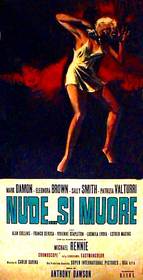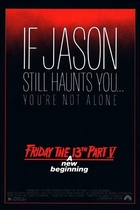Our editor-in-chief Nate Yapp is proud to have contributed to the new book Hidden Horror: A Celebration of 101 Underrated and Overlooked Fright Flicks, edited by Aaron Christensen. Another contributors include Anthony Timpone, B.J. Colangelo, Dave Alexander, Classic-Horror.com's own Robert C. Ring and John W. Bowen. Pick up a copy today from Amazon.com!
Naked You Die (1968)
You know you’re in trouble when the film you’re reviewing opens with a song that’s heavily reminiscent of the “Batman” theme (campy 1966 version). Still, other horror films have overcome a ridiculous pop tune – The Blob beat Burt Bacharach, didn’t it? Unfortunately, Antonio Margheriti’s Naked You Die resembles its theme song in more than a couple ways. It is a fairly disposable, imitative affair, packed with more goofy pep than seems appropriate for a “killer among us” film.
It’s summer vacation at St. Hilda College, a prestigious girl’s boarding school in England, and a handful of students with busy parents have stayed on campus for what promises to be fun in the sun. However, a killer is murdering these young ladies one by one, and his focus seems to be on Lucille (Eleonora Brown), an orphan who stands to inherit a large sum of money when she turns 18 in just a few short days. Is the killer La Floret (Luciano Pignozzi), the lecherous gardener who spies on the girls in the shower? Or is it Lucille’s amorous boyfriend Richard (Mark Damon), the riding instructor? Inspector Durand (Michael Rennie) is determined to find out and Jill (Sally Smith), a student with girl sleuth pretensions, is determined to help him, whether he likes it or not.
The original script for Naked You Die, at the time titled Cry Nightmare, was written by Italian horror great Mario Bava and the screenwriting team of Tudor Gates and Brian Degas. The plan was for Bava to direct the film himself, but the producers brought in Margheriti, Bava’s rival, as a partner. Bava left the production and Margheriti took over the director’s chair. According to Tim Lucas's exhaustive biography Mario Bava: All the Colors of the Dark, Margheriti used the Bava/Gates/Degas script almost exactly, with the expected changes to accommodate different casting and locations, as well as a smattering of new dialogue.1
While Bava’s involvement in any other project might be considered a boon, here it mainly serves to illustrate a few of his shortcomings as a writer. There are numerous plot elements that repeat from previous Bava excursions and the film might be considered a reconfiguration of Blood and Black Lace for teenage audiences. Another woman is murdered in her bathtub, another body is dragged through the woods, and another murderer in black gloves masks their avaricious motive by pretending to be a deranged psychopath. Given that Bava was a visually oriented director, he probably conceived how these sequences would play differently in this film or at least how he would cheekily acknowledge their redundancy. Indeed, Bava drew up several storyboards during the script-writing process (and Lucas suggests that Margheriti may have made use of a few of them).2 Without his sure eye behind the camera, however, Bava’s self-cannibalization is all too apparent, stripped of wit or added depth.
Of course, it’s probably silly to blame Bava for Naked You Die's script problems since he did believe he was going to direct the film, eventually. I fully believe he would’ve made Cry Nightmare work. It has the same semi-comedic tone of 1963’s The Girl Who Knew Too Much, which is a charming film (but by no means Bava’s best). Thus, we must repoint our finger of blame, and the obvious target is director Antonio Margheriti (credited, as always, under his Anglo-friendly pseudonym Anthony Dawson). Margheriti is a capable director, but the script is brimming with scenarios ready-made for Bava; unkind comparisons are inevitable. I have no evidence to suggest Bava saw the final product, but he might have been disappointed to find that color throughout Naked You Die is bright, naturalistic, and ultimately bland; the most visually arresting hue comes from girl detective Jill’s hideously orange dress (which is accented by a ridiculously large white tie). Margheriti and director of photography Fausto Zuccoli manage a few intriguing shots – particularly when looking at the prone forms of murdered girls – but for the most part, the cinematography is functional. We see what needs to be seen, with the camera’s distance from its subject in inverse proportion to the amount of suspense the scene is meant to generate. It’s a system that works in that it isn’t boring, but neither is it particularly exciting or notable.
I spoke of “goofy pep” in my opening. Indeed, Naked You Die has it, and most of it comes beaming from Sally Smith’s performance as the nosy, imaginative Jill. Jill’s the kind of teenager who takes all her comic books and mystery novels to heart, leading to a desire to be the hero of her own adventure. Smith perfectly captures this spirit with a bouncy energy – too much bouncy energy, in fact. When we first meet her, Jill is pushy and irritating, leaving one with a strong desire for her early, violent execution. Eventually, however, Smith is able to reverse this trend and show us a Jill who is smart and capable, if just a little too enthusiastic for her own good. When Jill eventually helps save the day, it’s a happy reward for her attempts at sleuthing throughout the film.
Sadly, Smith can’t save the film (and the poor dubbing of her character doesn’t help). There just isn’t enough to recommend it, really, especially when other films capture the same ideas and moods so much better. If you want a bouncy, zesty murder plot with an imaginative female protagonist, check out Bava’s The Girl Who Knew Too Much. If you crave moody murders of beautiful women, then your best bet is Bava’s Blood and Black Lace (1964). Look at that – Bava is better in both scenarios. Let that be a lesson for anyone contemplating Naked You Die.
1 Lucas, Tim. Mario Bava: All the Colors of the Dark. Video Watchdog, 2007. Pages 711-712, 715-716.
2 Ibid. Page 717.
Trivia:
Bava so enjoyed working with Tudor Gates and Brian Degas that he brought them on-board to write his next project, the comic book adaptation Danger: Diabolik.








